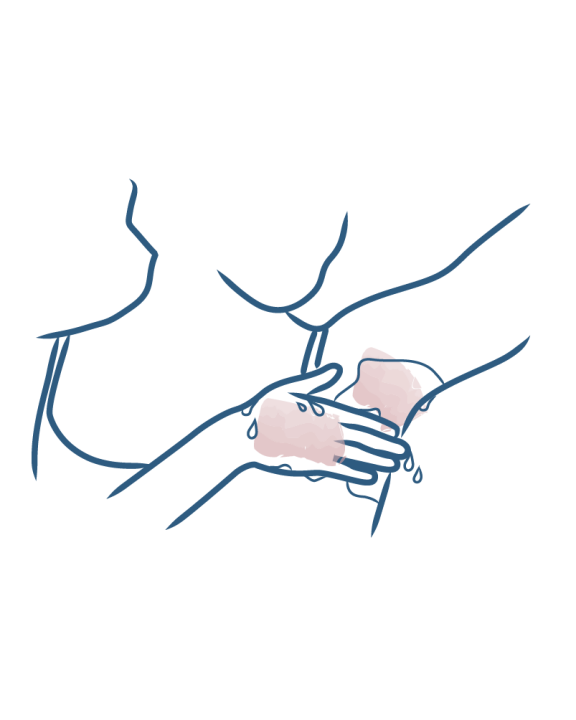What is hyperhidrosis?
- How to treat hyperhidrosis?
- Botulinum toxin injections for preventing hyperhidrosis
- Anticholinergic medication for preventing hyperhidrosis
- Managing stress and emotions
- Iontophoresis for preventing excessive perspiration
- Antiperspirant active ingredients for preventing hyperhidrosis
- Surgery for preventing hyperhidrosis
- Aluminium salts

What is hyperhidrosis?
Hyperhidrosis, more simply called excessive perspiration, is thought to affect between 0.6 and 2.8% of the population(1),(2). It occurs when the sweat production mechanism spirals out of control under the influence of various factors.
Perspiration: a natural phenomenon
What is sweat? It’s a natural phenomenon and essential for our body. It serves mainly to regulate our body temperature, to maintain it at 37 °C. Our body produces heat naturally, and when our internal temperature rises, for example after exercise, it triggers the sweating process to avoid overheating. It’s a kind of natural cooling system.
The region in our brain called the hypothalamus is responsible for this thermoregulation process, it acts as a sort of central thermostat. When our body temperature rises, it triggers the sweating process via the nervous system by activating sweat glands to produce sweat.
The role of sweat glands and sweat?
Sweat is produced by sweat glands. These are small glands found in the skin’s dermis.
Approximately 4 million sweat glands cover our body, and there are two types of gland:
- Eccrine sweat glands: present all over our body, but more concentrated on the palms of our hands, forehead and soles of our feet. They produce an odorless sweat which is then eliminated through the pores of the skin.
- Apocrine sweat glands: they are associated with a hair and are found only on certain areas of the body, notably in the armpits and groin. The sweat they produce contains organic molecules which the bacteria present on our skin surface break down, and it is this that causes bad smells to develop. The presence of hairs makes these bad smells worse, as they retain the sweat and therefore increase the likelihood of maceration. These glands are active only from puberty, under the influence of hormones.
What is sweat?
When we perspire, our body evacuates sweat through the skin’s pores. The composition of sweat depends on many factors, including familial and individual predisposition and diet. Sweat contains 99% water, minerals and some body waste (urea, etc.). It has an acid pH, close to the physiological pH of the skin (5.5).
Hyperhidrosis, excessive perspiration
If sweating is a natural phenomenon, essential for our body, what is hyperhidrosis? Hyperhidrosis is a sweating disease. People with this disease suffer from oversweating.
It causes excessive perspiration in both men and women, is not always associated with an identifiable cause, and can appear in childhood or adolescence. There is also what we call secondary hyperhidrosis, induced by a disease or a treatment. Determining the precise cause of excessive perspiration, the contributing factors and a treatment can help improve hyperhidrosis.
Hyperhidrosis: localized or widespread?
In 90% of cases, hyperhidrosis is localized and bilateral, i.e. it affects both sides of the body symmetrically. The phenomenon then affects only certain areas of the body, for example the hands, feet, face and/or armpits. More rarely, it can be widespread and affect the whole body. If hyperhidrosis begins suddenly in adulthood, it is very probably the result of another disease. It is therefore best to consult a doctor if hyperhidrosis occurs suddenly, in order to establish the cause.
Have I got hyperhidrosis?
There is no exact definition of hyperhidrosis, since no link has been established between hyperhidrosis and a specific quantity of sweat. We therefore use the terms excessive perspiration or oversweating when it becomes a big problem in everyday life, for example if it prevents you from holding out your hand to say hello, from dressing as you wish, from practicing a sport for fear of sweating, from leaving the house when it’s a bit hot, etc.
Hyperhidrosis, an everyday problem
Hyperhidrosis is very incapacitating for those suffering from it, it can result in social withdrawal and have a serious impact on daily life. Excessive perspiration is often wrongly associated with poor hygiene, and it can therefore be difficult when people are judgemental. Some people may be too embarrassed to talk to a doctor. In fact, it is estimated that only 38%(3) have discussed their problem with a health professional. Yet very effective solutions do exist.
(1) Stolman LP. Treatment of hyperhidrosis. Dermatol Clin 1998;16:863-9
(2) Münchau A, Bhatia KP. Uses of botulinum toxin injection in medicine today. BMJ 2000;320:161-5
(3) Strutton D.R., Kowalski J.W., Glaser D.A., et al. US prevalence of hyperhidrosis and impact on individuals with axillary hyperhidrosis: results from a national survey. Journal of American Academy of Dermatology, 2004, 51: 241–248
Our care routines
Excessive perspiration

